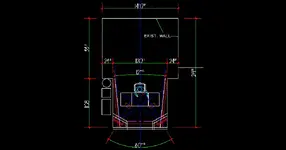Jack Russell
I smell home cookin!
Well, I'm moving along slowly but surely on a basement studio project. I'll attach the layout also (kindly done before by R. Fitzpatrick).
As with most projects you wake up one day and say "What the hell!? I just forgot something!" So, today I realized that the 5-inch lighting cans I've planned for the ceiling might not work with the floating cloud(s) that will hang below them. Duh!!!
In the rehearsal/recording end of my studio plan I was going to place 4 resessed light cans. Now I'm wondering if I should leave these out.
Question 1: Would a good solution be to go ahead with the 4 lights, but plan on putting separate floating clouds up near the ceiling but between the lights? That is, within 4 inches of the ceiling?
I also will have a separate cloud over the mixing position.
Quesiton 2: Am I correct in concluding that a cloud over the mixing area should be spaced lower from the ceiling than those in the back end? Perhaps a foot lower?
Ceilings are all 9 foot, by the way. Or 8' 10" precisely.
As with most projects you wake up one day and say "What the hell!? I just forgot something!" So, today I realized that the 5-inch lighting cans I've planned for the ceiling might not work with the floating cloud(s) that will hang below them. Duh!!!
In the rehearsal/recording end of my studio plan I was going to place 4 resessed light cans. Now I'm wondering if I should leave these out.
Question 1: Would a good solution be to go ahead with the 4 lights, but plan on putting separate floating clouds up near the ceiling but between the lights? That is, within 4 inches of the ceiling?
I also will have a separate cloud over the mixing position.
Quesiton 2: Am I correct in concluding that a cloud over the mixing area should be spaced lower from the ceiling than those in the back end? Perhaps a foot lower?
Ceilings are all 9 foot, by the way. Or 8' 10" precisely.




